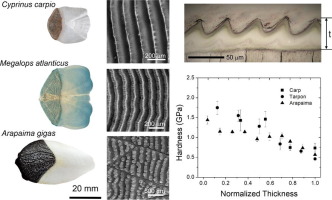Acta Biomaterialia ( IF 9.4 ) Pub Date : 2017-12-14 , DOI: 10.1016/j.actbio.2017.12.011 D. Arola , S. Murcia , M. Stossel , R. Pahuja , T. Linley , Arun Devaraj , M. Ramulu , E.A. Ossa , J. Wang

|
Fish scales serve as a flexible natural armor that have received increasing attention across the materials community. Most efforts in this area have focused on the composite structure of the predominately organic elasmodine, and limited work addresses the highly mineralized external portion known as the Limiting Layer (LL). This coating serves as the first barrier to external threats and plays an important role in resisting puncture. In this investigation the structure, composition and mechanical behavior of the LL were explored for three different fish, including the arapaima (Arapaima gigas), the tarpon (Megalops atlanticus) and the carp (Cyprinus carpio). The scales of these three fish have received the most attention within the materials community. Features of the LL were evaluated with respect to anatomical position to distinguish site-specific functional differences. Results show that there are significant differences in the surface morphology of the LL from posterior and anterior regions in the scales, and between the three fish species. The calcium to phosphorus ratio and the mineral to collagen ratios of the LL are not equivalent among the three fish. Results from nanoindentation showed that the LL of tarpon scales is the hardest, followed by the carp and the arapaima and the differences in hardness are related to the apatite structure, possibly induced by the growth rate and environment of each fish.
Statement of Significance
The natural armor of fish, turtles and other animals, has become a topic of substantial scientific interest. The majority of investigations have focused on the more highly organic layer known as the elasmodine. The present study addresses the highly mineralized external portion known as the Limiting Layer (LL). Specifically, the structure, composition and mechanical behavior of the LL were explored for three different fish, including the arapaima (Arapaima gigas), the tarpon (Megalops atlanticus) and the carp (Cyprinus carpio). Results show that there are significant differences in the surface morphology of the LL from posterior and anterior regions in the scales, and between the three species. In addition, the composition of the LL is also unique among the three fish. Results from nanoindentation showed that the LL of tarpon scales is the hardest, followed by the carp and the arapaima and the differences in hardness are related to the apatite structure, possibly induced by the growth rate and environment of each fish. In addition, a new feature was indentified in the LL, which has not been discussed before. As such, we feel this work is unique and makes a significant contribution to the field.
中文翻译:

鱼鳞的限制层:结构和性质
鱼鳞作为一种灵活的天然盔甲,在整个材料界受到越来越多的关注。该领域的大多数努力都集中在主要是有机弹性石的复合结构上,而有限的工作针对的是高度矿化的外部,即所谓的限制层(LL)。这种涂层是抵御外部威胁的第一道屏障,在抵抗穿刺方面起着重要作用。在这项调查中,探索了三种不同鱼类的LL的结构,组成和力学行为,包括arapaima(Arapaima gigas),tarpon (Megalops atlanticus)和鲤鱼(Cyprinus carpio))。这三种鱼的鳞片在材料界受到了最多的关注。针对解剖位置评估LL的特征,以区分特定部位的功能差异。结果表明,在鳞片的前后区域以及三种鱼类之间,LL的表面形态存在显着差异。在这三种鱼中,LL的钙磷比率和矿物质与胶原比率不相等。纳米压痕的结果表明,tar鱼鳞的LL最硬,其次是鲤鱼和阿拉巴马,硬度的差异与磷灰石的结构有关,可能是由每条鱼的生长速度和环境引起的。
重要声明
鱼,乌龟和其他动物的天生盔甲已成为具有重大科学意义的话题。大多数研究都集中在有机质更高的层(称为弹性纤维)上。本研究解决了高度矿化的外部,即限制层(LL)。具体来说,探索了三种不同鱼类的LL的结构,组成和力学行为,包括arapaima(Arapaima gigas),tarpon(Megalops atlanticus)和鲤鱼(Cyprinus carpio)。结果表明,在鳞片的后部和前部以及三种物种之间,LL的表面形态存在显着差异。此外,LL的组成在这三种鱼中也是独特的。纳米压痕的结果表明,棉卷鱼鳞的LL最难,其次是鲤鱼和沙棘,其硬度的差异与磷灰石的结构有关,这可能是由每条鱼的生长速度和环境引起的。另外,在LL中发现了一个新功能,以前没有讨论过。因此,我们认为这项工作是独一无二的,并为该领域做出了重大贡献。











































 京公网安备 11010802027423号
京公网安备 11010802027423号